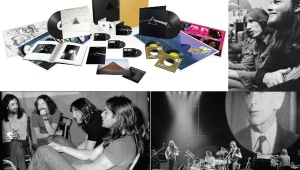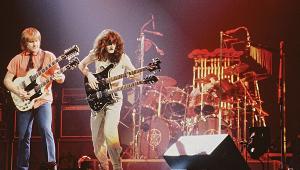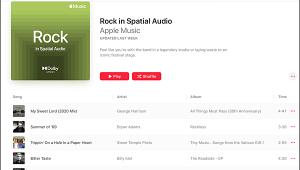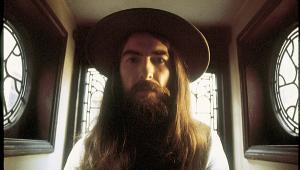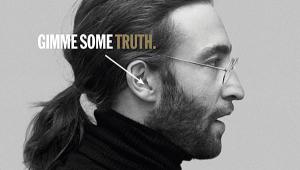Their music eggy car is incredible, and it changed my life.
Recording and Remixing Revolver Page 3
The perfect follow-up to “Tomorrow Never Knows” was, of course. . . . “Got to Get You Into My Life?” Well, that’s what came after “Tomorrow” was completed later that evening on April 7. The group moved to the larger Studio 2 and recorded a rhythm track with organ, acoustic guitar, and drums and started on vocals.
When they returned to the studio the following day, they returned to Studio 3 and took a new approach, which is what we hear on the final release. A new rhythm track was recorded, with all four playing with George mirroring Paul’s bass line on a fuzzed rhythm guitar in another track, and including important guitar riffs that would be replaced a month later with horns playing George’s riffs. If you listen closely, you can hear George’s original riffs as leakage on quiet breaks in the song (another Beatles mystery solved). The parts can also be heard clearly on one of the Sessions outtakes included with the Super Deluxe packages, courtesy of an early mix done prior to overdubbing of the horns.
Love You To
The Beatles returned on Monday, April 11 to Studio 2 with yet another illustration of their new, varied palette — George’s “Love You To,” a song mostly featuring Indian instruments and George playing sitar. The recording began with rhythm provided by George’s acoustic guitar and can be heard as a Sessions track. Take 5, which represents the released version, has the two main players: George playing a sitar he purchased at London’s Indiacraft shop and Paul on tamboura, the Indian drone instrument. Also present as a Sessions track is a previously-unknown rehearsal take, found on the end of the reel.
“There’s always been that great debate,” says Howlett. “Is George really playing sitar on ‘Love You To?’ And that additional track, ‘Unnumbered Rehearsal,’ really answers that. You can hear Paul and George. Paul is playing the tamboura…and shouting, ‘Ow! Ow!’ because his thumb is hurting from playing it. And you can clearly hear George playing the sitar parts and singing to himself” — something tabla player Anil Bhagwat, recruited for the sessions by George from his friends at the Angadis’ Asian Music Circle, confirmed. “I can tell you here and now, 100%, it is George playing the sitar throughout.” George also added a distorted electric guitar, heard in parts.
Paperback Writer
Two days later, on Wednesday, April 13, the group returned to Studio 3 and moved on to what would be their next single and the first true rock song of the sessions so far.
The British music industry was at this time still in the mode of artists issuing non-album tracks as standalone singles, and The Beatles were no exception. They hadn’t had released a single since December’s double-A-sided “Day Tripper” / “We Can Work It Out, and the public was beginning to notice. Was something up? “I was actually 9 at the time,” Howlett recalls, “and I do remember thinking, ‘Why have they disappeared? They didn’t do a Christmas show and they’d stopped doing BBC Radio sessions. There was a big gap. They knew they needed [a single] and ‘Tomorrow Never Knows’ wasn’t it!” George’s response to the question when asked by the BBC’s Brian Mathew, was, “Well, you know, it takes a long time to record now. And we prefer recording.”
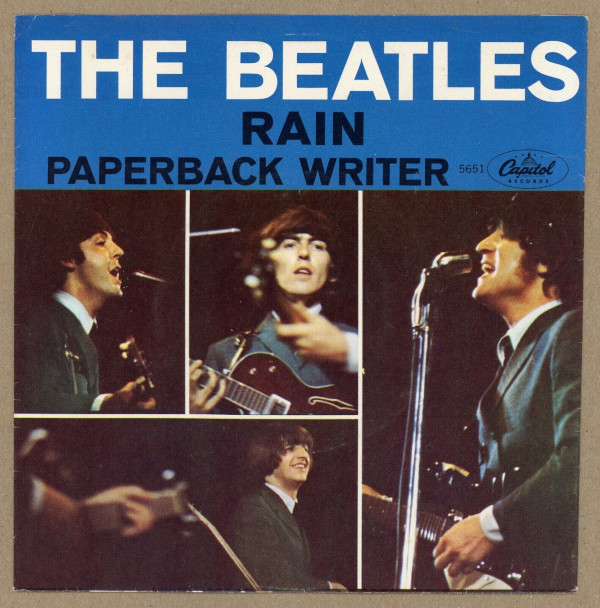
Whether “Paperback Writer” and “Rain,” recorded the following day, were brought in as the next album tracks or recorded specifically as the single with Rain as the B-side, is unknown, though Howlett contends, “I think they knew they were recording the single.”
“Paperback Writer” was released several months ahead of the album, giving the public a hint of things to come. “It amalgamates, in many ways, everything that was different — and Geoff felt that way, too,” says Bill Smith. “It’s a tonal change. It’s aggression. They’d never done a song like ‘Paperback Writer’ before — that chugging, straight-in-your-face rock and roll, loud and distorted. This was the beginning of everything that was to follow it — a definitive line in the sand, after Rubber Soul.”
On the backing track outtakes on the Sessions disc, you can easily hear McCartney’s excitement as he leads John (playing a tremoloed rhythm guitar), Ringo, and George (on tambourine — George would add a guitar part later as an overdub) through two takes. Paul’s own guitar playing, on his Epiphone Casino, is raucous, distorted, and powerful — it’s the main driver of the song and demonstrates how far his abilities as a guitarist had come. It’s also clear that his remarkable arrangement was clearly planned out as he can be heard quietly singing a guide vocal for what will be the “Paperback Writer” a cappella vocal introduction/parts — soon to be beautifully and skillfully embellished in overdubs.
Paul’s bass, recorded as an overdub, is the other key sound on the song. “Paul began to hear and want better sounds, particularly on ‘Paperback Writer’ and ‘Rain,’” Emerick recalled. Adds Smith, “This song, with its chugging, rocking, raging, distorted guitars demanded a more pumping, active bass part. And, frankly, when did you ever heard Paul play bass like that on a record?”
Familiar with the powerful bass he had heard on American records – a sound The Beatles were looking for — Emerick admitted, “I was grasping at straws” on how to give Paul what he wanted. He considered utilizing a loudspeaker as a microphone, placed against his (likely) Vox 7120 amp. “My theory was, if a loudspeaker could push it out, a loudspeaker could take it in — if you reversed it and used it as a microphone.” Kehew elaborates: “A large speaker tends to pick up low frequencies. So one can use a speaker as a mic, and pick up more of those frequencies. It’s not done very often, because it usually doesn’t sound very good. But it made quite a difference here.” Emerick noted that the arrangement was used solely for “Paperback Writer,” and not for “Rain,” though that bass part is equally impressive.
Ken Townsend had the same idea, and so, employed one of EMI’s “White Elephants” to do the job. Prior to these recordings, when recording overdubs, The Beatles would hear playback of the previously-recorded material via a speaker system enclosed in a large, standing white enclosure. [For those who understand microphone pickup patterns, when they were, say, recording a vocal overdub, the Neumann microphone would be set to a figure-8 pattern, with the White Elephant placed 90 degrees off axis from the pickup axis — preventing its output from being picked up by the mic.] “Ken would have had to remove the back and make a different kind of connection, since a speaker has a different connection than a microphone cable,” Kehew explains. “And, like any microphone, it’s a weak signal — at “mic level’ — so he would have boosted it to ‘line level’ through one of the studio’s many preamp systems so that it could be introduced as a line input in the mixing console.”
Some of the song’s vocal and other overdubs were addressed the following day on Thursday, April 14, after which the song was mixed for mono.
Another signature sound of “Paperback Writer” is the echo effect that kicks in at the end of verses just before chorus. As noted earlier, the effect was created during mixing using Ken Townsend’s new ADT setup. Emerick would have created a send output to the BTR2’s tape machine’s input, with the Varispeed set to provide a (comparatively) slower echo than that used for true ADT. To cycle the ADT into the signal path — and back out again — explains Kehew, “It’s possible that either the Record Level knob or the Output Level knob on the front of the BTR2 would have been toggled on or off, on Geoff’s cue to Phil McDonald.” Adds Smith, “And it probably took them several times/tries to kill it at exactly the right spot — with the right number of cycles and ending at exactly the right spot.”
Interestingly, Emerick considered the single’s original mono mix (which is included on a bonus EP) as the only way to hear “Paperback Writer.” To his ear, it was perfect, in contrast with the stereo mix created later that year for the song’s appearance on the U.K. LP, A Collection of Beatles Oldies. “The mono mix just roars out of the speakers in a way the stereo doesn’t. It was designed to be heard in mono. The explosiveness and aggression are just lost on the original stereo.”
Part of that explosiveness was due to Paul’s powerful bass playing, which was captured brilliantly by Emerick. Such strong bass levels were normally prohibited because they could cause the stylus to bounce out of the record groove on consumer turntables, though a system called Automatic Transient Overload Control, or ATOC, was developed for use in the cutting room to deal with just this situation. The system used a second head in advance of the cutting head on the cutting lathe to look for strong transients. The system would momentarily adjust groove width to account for the more powerful signal in that moment.
Rain
Later on the 14th, the single’s B-side was recorded, with John playing a Gretsch 6120 hollow body electric guitar, not seen much of after that (though Andy Babiuk found it at the home of one of John’s cousins, who had been given the instrument at some point).
“Rain” has its own unique sound that was created using another new technique called speed change, used here to produce a specific texture. “They never used it as a gimmick,” says Howlett. “It always suited the atmosphere of the song.” Notes Kehew, “One of the effects of psychedelia, specifically mind-altering drugs, is the perception that the universe bends and changes. Trees can melt, time can stretch. So the Beatles are starting to stretch audio. This is the audio equivalent of a psychedelic experience,” one that, no doubt, connected with listeners who were also beginning to have psychedelic experiences around this time.
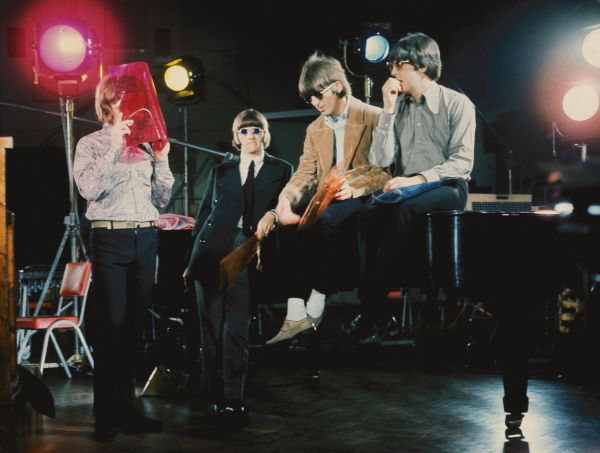
The genius here is that The Beatles knew they wanted to slow the recording down, so they recorded the rhythm track really fast in B-flat major so when it was slowed down from the standard 50kHz to 42kHz, it played at a slower but more natural rhythm that was close to G major but now with that weird quality they were after. (You can hear the actual speed of the original playing on a raw recording on one of the Sessions discs.)
Ringo has often cited “Rain” as his favorite Beatles drum part, which brings up something interesting, which Kehew, who has remixed countless classic recordings, explains. “When you slow something down, not only does it become slower and lower in pitch, but the timing gets worse. The fact that Ringo’s drums are nailed at a slower speed points to the fact that his playing is just that good. Even slowed down, his drumming is precise and right in the pocket.”
The complicated tracking process is detailed in the Deluxe book, indicating John and Paul on guitars and Ringo drumming, recorded at 50 kHz on Track 1, with bass added at that speed as an overdub. The tape was then slowed down to 42 kHz for the addition of John’s vocals, which, when mixed at that same speed, sounded normal, while the music did not. Background vocals and Paul’s harmonies were added to a reduction mix. “Thankfully,” says Howlett, “we’ve got tape boxes, recording sheets, and our ears to figure out what’s happening in the process.”
John famously had taken a tape of a rough mix home and, not realizing it had been saved “tails out” (with the end appearing first, requiring it to be rewound to be played), put it on his machine and played it backwards. High on hashish, he listened and marveled at what he heard. When he arrived at the studio the next day, he requested his vocal appear backwards on the recording. So Martin and Emerick created a selection of phrases, which skillfully fit the timing of the rhythm track during the song’s coda — and, of course, blew everyone’s mind who heard it.
The Beatles had Friday, August 15 off, and on Saturday, August 16, the overdubs were added and the song was mixed for mono using ADT for the first time on John’s vocal (the reason the process was created!). The stereo mix of Rain would not come for another three years, in December 1969, when it was decided both sides of the single would be included on Capitol/Apple’s February 1970 LP release, Hey Jude.
Doctor Robert
“Doctor Robert,” recorded the next day, on Sunday, April 17, with overdubs two days later, was fairly straightforward. Notable is the inclusion on a Sessions disc of the raw recording in which the band had accidentally played the middle 8 section an extra time, which John notes at the end of that take’s recording. And, by the way, that’s John playing the organ, during the “Well, well, well” sections.
And Your Bird Can Sing
On Wednesday, April 20, The Beatles took their first pass at John’s “And Your Bird Can Sing” (originally titled “You Don’t Get Me” on his handwritten lyrics, as seen in the Deluxe book). This first version featured a rhythm track with John on 6-string and George on his Rick 12-string, giving the song a beautiful, but very Byrds-like, feel. That version also began receiving overdubs that day, including the “giggling version” of the song, heard on Anthology 2, when John and Paul were attempting to double-track their first vocal track. (Both versions appear here on Sessions).
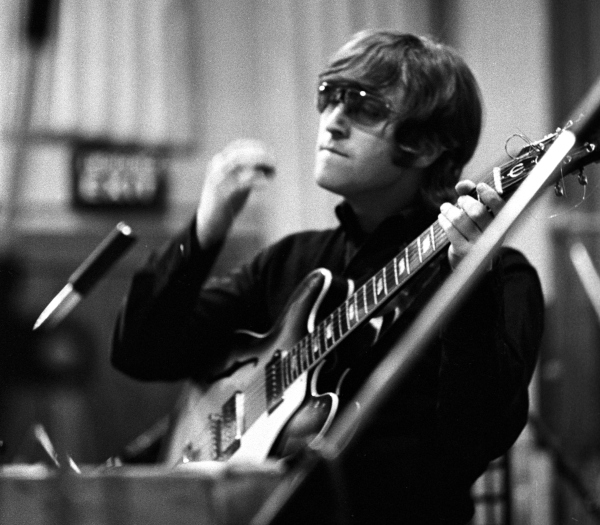
They came back to the song to try two more different versions the following week, on Tuesday, April 26. The first version just had John playing rhythm guitar, with George playing the song’s signature riff on a 6-string guitar in a nice, almost country-ish style, bending notes. That version (presented on the Sessions disc) also began receiving overdubs. But the final version that day, Take 10, featured John playing a simple rhythm, Paul on bass, and Ringo on drums. But then, Paul once again showed his prowess as a guitar player as he and George play the riff and solo parts together in harmony with distortion — perfectly. As Paul is quoted in the book, “It’s a harmony riff. George and I would work out a melody line, then I would work out the harmony to it. So we’d do it as a piece. It’s just the two of us, live.”
“It’s a foretaste of things to come,” Sam Okell notes. “The man can play everything really well.”
Taxman
Back on the 20th, after the first attempt at “And Your Bird Can Sing,” the group rehearsed George’s next track for the album, “Taxman,” which was then recorded the following day, on Thursday, April 21, with overdubs added the day after. The song was eventually chosen to open the album.
And in case you’ve always wondered who’s counting the song in, Howlett finally reveals the answer. “I know there’s been debate about it, but it’s clearly Paul. I know that deep voice Paul puts on — I’ve heard it on other session tapes. At the beginning of a vocal overdub track you can hear Paul messing around, going, ‘One. . . two. . . three. . . four.” It’s not something that was added at some later date. We even went as far as to check the 4-track tape, to see if there were any edits, and there were none. It’s Paul.”
- Log in or register to post comments


bubble slides https://bubslides.com/

Featuring newly remastered versions of the album's original tracks, as well as a wealth of previously fnf unreleased material, including outtakes, demos, and alternate versions of classic songs, these special editions offer a fascinating glimpse into the creative process of one of the most influential bands in music history.

The powerful "Super Beetle" amplifier The Beatles used on their 1966 U.S. tour was built using cutting-edge rankdle solid-state technology. A new guitar amp with a solid-state preamp that sent the signal to Vox's trusty tube output was where the circuit design first made an appearance. And that's the model 7120, which you mostly see them utilizing at the Revolver studio, according to Babiuk.

I sincerely appreciate the knowledge you share on your website because learning new things makes me so happy, and I hope you have a great time playing getting over it

When making the documentary The Beatles: Get Back, director Peter Jackson's WingNut team used the same artificial intelligence-based "demixing" nyt connections technology. Martin and his team were able to reinvent Revolver thanks to demixing.

The Watermelon Game global popularity is a testament to its universal appeal, inviting players from different countries to immerse themselves in a world of fruity delight and strategic challenges.

Drift Hunters is an awesome drift racing game! I love how it creates a powerful feeling when sledding, with stunning visual and sound effects. Being able to customize and upgrade your vehicle adds to the fun and creates personalized drift cars."

This article will delve into MD-102, rice purity test exploring its key aspects, answering common questions, and providing valuable insights.

Thanks for the helpful tips! I'll definitely be applying them in my own endeavors. wickedwhims

This post is the most-awaited and informative. I am reading your article very enjoying it. Your good choice for the topic. You more articles are written on other topics. I already some articles read but your article is very helpful to me tubi tv activate.

I admire you sharing this excellent and helpful information. To find out more about activation and other information, you may also visit my website wickedwhims.

I read your message, and I thought it was quite insightful and helpful. I appreciate the thoughtful information you include in your publications. You can find out more by visiting my website. beachbodyondemand.com/activate

Disney Plus is a treasure trove of storytelling brilliance. With its vast library of beloved classics and exciting originals, I'm constantly captivated by the magic of Disney. Whether I'm revisiting timeless favorites or discovering new adventures, Disney Plus never fails to transport me to worlds beyond imagination. disneyplus.com/begin

Thank you for addressing this important issue in your blog. Your commitment to raising awareness and fostering discussion is commendable. tubi.tv/activate

Discover a new era of connectivity with Xfinity com authorizes. Experience lightning-fast internet, customizable TV options, and reliable phone services tailored to your lifestyle. Join us and redefine connectivity. xfinity.com/authorize

Obsessed with the nostalgic feels Disney+ brings. It's like being transported back to simpler times, curled up with a good movie and some popcorn. Disneyplus.com/start

Hey There. I found your blog. This is a really well written article tubi.tv/activate.

This post exceeded my expectations in every way. It's informative, well-written, and incredibly engaging. I can't wait to see what you come up with next! https://iforgottapple.com/

This is a fantastic article! The depth of your analysis is impressive and provides a lot of value to readers. Thank you for sharing! https://iforgottapple.com/

Awesome post! Your insights on this topic are truly enlightening and provide a fresh perspective. Keep up the great work! https://soapp2dayy.com/

This article demonstrates a keen understanding of industry challenges. Very informative and well-written. https://lowes-comsurvey.com/

Your approach to this topic is commendable. Clear, concise, and packed with actionable insights. https://ppacmann.com/30th-anniversary/

Absolutely delighted with the insightful content shared by the HTN Corporation on their website! The articles are not only informative but also genuinely uplifting. It's evident that the authors put a lot of effort into crafting such valuable resources. Keep up the great work! For more enriching reads, visit AI in Traffic Management. https://htn-expert.com/projects

Amazing post! I found your perspective on this issue very compelling. Your writing always leaves me with something to think about. https://disneyplusdisney.com/begin/

Certainly fantastic effort! It is encouraging to read such insightful and effectively presented thoughts. It was both entertaining and beautifully written. For additional resources and professional help, visit SEO Services. https://ai-seoservices.com

It's really good to read this post , Thanks for sharing Fashion Trends 2024
https://yardofdeals.com
https://yardofdeals.com/collections/premium-t-shirts-collection

Certainly fantastic effort! It is encouraging to read such insightful and effectively presented thoughts. It was both entertaining and beautifully written. For additional resources and professional help, visit SEO Agency for more information.

Thank you for the great insights! Your blog always provides the best information. Keep up the excellent work! https://hulu-com-activate.com/

All of these things are just blowing his mind. And George has developed a passion for Indian music. And, of course, when one Beatle has a passion, they all share it.”

Excellent post! I appreciate the thorough research and thoughtful commentary. This is a must-read for anyone interested in this subject. disneyplus.com/begin

When considering a Checkbook IRA, understanding the associated fees is crucial for effective financial planning. checkbook ira fees typically involve management fees, transaction fees, and setup fees, which can vary based on the custodian. These fees may cover services like account maintenance, wire transfers, and asset purchases. By choosing a provider that offers transparent fee structures, you can better manage your investments and maximize your retirement savings. Always review the fee schedule carefully to ensure you're making an informed decision.

As a Digital Consultant with over 20 years of experience, I collaborate with a network of trusted partners to help you close your digital gap. We don’t believe in one-size-fits-all solutions; instead, we work closely with you and your teams to identify specific opportunities for digital transformation, including strategies for effective Organic Search engine optimisation. By tailoring our approach to your unique challenges, we ensure that your business can thrive in the digital landscape.

This complete article investigates Lowe's excursion, values, client driven approach, supportability drives, and its vision for the future, www.Lowes.com/Survey
displaying why Lowe's remaining parts a confided in name in the home improvement industry.

Wonderful post! I’ve bookmarked it for future reference. Also, if anyone hasn’t tried tv.youtube.com/start yet, you’re missing out on great content!

This post is absolutely insightful! The information shared here has truly broadened my perspective on the topic, I can’t wait to apply some of these strategies in my own work. Thank you for providing such valuable content!
Mcafee.com/activate

This post is so thorough and well-written; it is obvious that a lot of work went into researching and presenting these points. I have learned a lot, and I will definitely share it with my network.
ifrogot.apple.com

